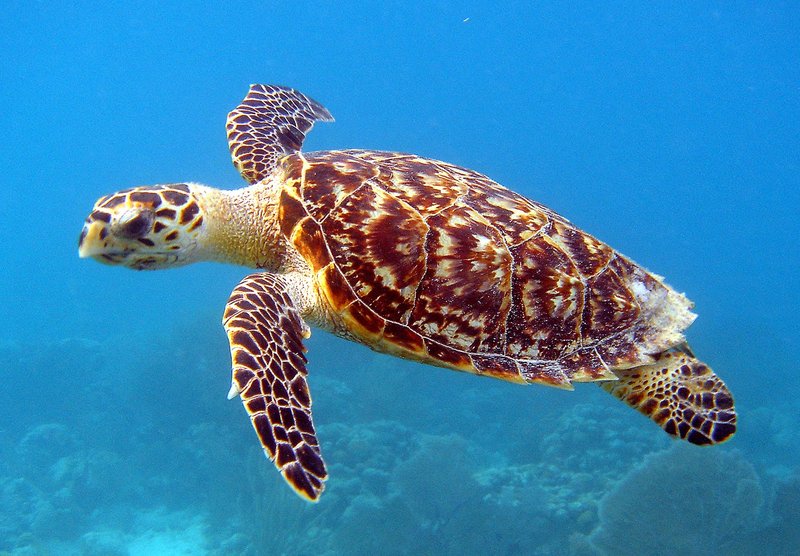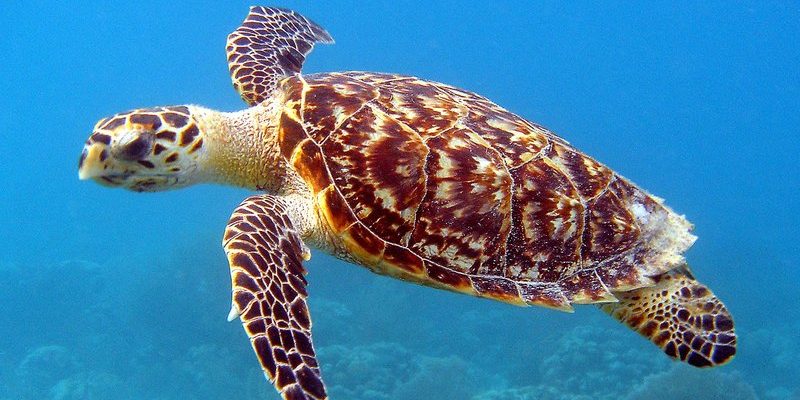
These turtles aren’t just pretty faces; they play a crucial role in maintaining the health of coral reefs and the wider marine ecosystem. The more you learn about them, the more fascinating they become. So, let’s dive into ten cool things you probably didn’t know about these remarkable turtles—who knows, you might just find your new favorite sea creature!
1. Distinctive Shell Patterns
The Hawksbill turtle is easily recognizable thanks to its beautiful, intricate shell. Each turtle’s shell, or carapace, is adorned with unique patterns that vary from one individual to another. It’s kind of like how humans have unique fingerprints—no two Hawksbill turtles are exactly alike!
These patterns are usually a mix of amber, brown, and yellow hues, giving the Hawksbill its striking appearance. But there’s more to the shell than meets the eye! The Hawksbill’s shell is not just for show; it also serves a vital purpose in protecting the turtle from potential predators.
2. Coral Reef Helpers
Here’s the thing: Hawksbill turtles are more than just pretty creatures; they are essential to the health of coral reefs. They primarily feed on sponges, which helps keep the sponge population in check. Without the Hawksbill’s diet, sponges can overgrow and suffocate coral reefs, leading to a decline in the overall health of these ecosystems.
Think of the Hawksbill turtle as the gardener of the sea—by munching on sponges, they’re keeping the colorful coral gardens healthy and thriving. If you love snorkeling or diving in vibrant coral reefs, you’re likely seeing the positive effects of these turtles’ feeding habits firsthand!
3. Nurturing Maternity Practices
Female Hawksbill turtles have a fascinating nesting behavior. They return to the same beaches where they were born to lay their eggs. This behavior is called “natal homing,” and it can be quite a journey!
After a long trip back to their birthplace, a female will dig a nest in the sand and lay around 160 eggs. Here’s a thought: a single nesting female can return to the beach multiple times during a nesting season. The dedication they show in choosing their nesting site adds to the deep connection they have with their home, ensuring that the next generation has a safe place to hatch.
4. They’re Not Super Fast Swimmers
When you think of sea turtles, the word “graceful” might come to mind. However, compared to some other sea creatures, the Hawksbill isn’t the fastest swimmer in the ocean. On average, they swim at a leisurely pace of about 2 to 3 miles per hour.
You might be wondering why their slower speed is a good thing. It allows them to conserve energy and may even help them avoid predators. Their speed doesn’t hinder their ability to navigate vast ocean spaces. They’re incredibly skilled at finding food and avoiding danger, all while embracing their peaceful pace.
5. They’re Critically Endangered
Sadly, the Hawksbill turtle is classified as “critically endangered” due to various threats. Habitat loss, illegal trade, and climate change are just a few of the challenges these turtles face. Their beautiful shells are often sought after in the illegal tortoiseshell trade.
This situation is a reminder of why we need to protect these magnificent creatures. Conservation efforts are ongoing, focusing on protecting nesting sites, reducing bycatch, and raising awareness about their plight. You can play a part by supporting organizations dedicated to sea turtle conservation and spreading the word!
6. They Communicate Underwater
Believe it or not, Hawksbill turtles have a way of communicating with each other while underwater. They are known to make a variety of sounds, like clicks and whistles, which can indicate emotions or alert other turtles to danger.
Imagine being underwater without needing to talk! Instead, you could share your thoughts and feelings through a series of clicks, just like a secret underwater language. This communication can help them stay connected with each other, especially in the expansive ocean where they might not see another turtle for a while.
7. Long Lifespan
Hawksbill turtles can live a long time—some estimates suggest they can reach up to 50 years or more! Their longevity allows them to contribute to the marine ecosystem for many decades.
Here’s the twist: while they can live long lives, they often don’t reach adulthood due to various threats. So, those lucky enough to survive to adulthood can make a significant impact on their environment during their long lives. It’s a reminder of how important it is to protect the lives of younger turtles so they can grow up and lead a fulfilling life!
8. They Can Hold Their Breath
Hawksbill turtles are fantastic divers. They can hold their breath for up to 30 minutes or more while foraging for food. This ability is pretty impressive when you consider how much time they spend underwater.
When you think about it, holding your breath for that long would be quite a challenge for most people! Their adaptations enable them to dive deep into the ocean to seek out their favorite snacks. It’s all just part of being an incredible ocean creature.
9. They Are Important Indicators of Ocean Health
Because of their role in the ecosystem, Hawksbill turtles can serve as indicators of the overall health of the ocean. Scientists often study their populations and health to gauge the state of coral reefs and marine environments.
When Hawksbill turtles are thriving, it’s a good sign that their habitat is healthy. Conversely, if their numbers are dwindling, it might indicate larger problems in the marine ecosystem. It’s like having a living weather vane that tells us how well our oceans are doing!
10. The Mystique of Their Migrations
Hawksbill turtles are known to embark on long migrations, often traveling thousands of miles between feeding and nesting areas. This journey isn’t just a leisurely swim; it’s a significant trek across open ocean.
Although scientists are still uncovering all the details, some researchers believe that Hawksbills navigate using the Earth’s magnetic fields—a truly awe-inspiring feat. Imagine setting out on a journey with no map, relying entirely on your sense of direction! It’s a testament to their incredible instinct and adaptability.
In conclusion, the Hawksbill turtle is a remarkable creature that many of us take for granted. From its stunning shell to its crucial role in the marine ecosystem, there’s so much to appreciate about this endangered species. As we learn more, we can better protect them and the environments they inhabit. Let’s celebrate the Hawksbill and work together to ensure that future generations can marvel at these incredible turtles as we do today!

